Ethical Dilemmas: An Analysis of the Right to Die in the Schiavo Case
VerifiedAdded on 2022/08/23
|5
|1238
|14
Essay
AI Summary
This essay delves into the controversial Terri Schiavo case, a pivotal moment in the debate surrounding the right to die. The assignment analyzes the legal and ethical arguments presented by both Michael Schiavo, Terri's husband, and her parents, who held opposing views on her end-of-life care. The essay provides a detailed account of the events leading up to Terri's death, including her medical condition, the legal battles, and the involvement of political figures. It explores the complexities of persistent vegetative states, the role of living wills, and the conflicting interests of family members. The author examines the court's decisions, the evidence presented, and the ethical implications of each side's claims. Through a critical analysis of the case, the essay aims to shed light on the broader questions of individual autonomy, medical ethics, and the right to make end-of-life decisions, ultimately arguing against the court's verdict in favor of Michael Schiavo.
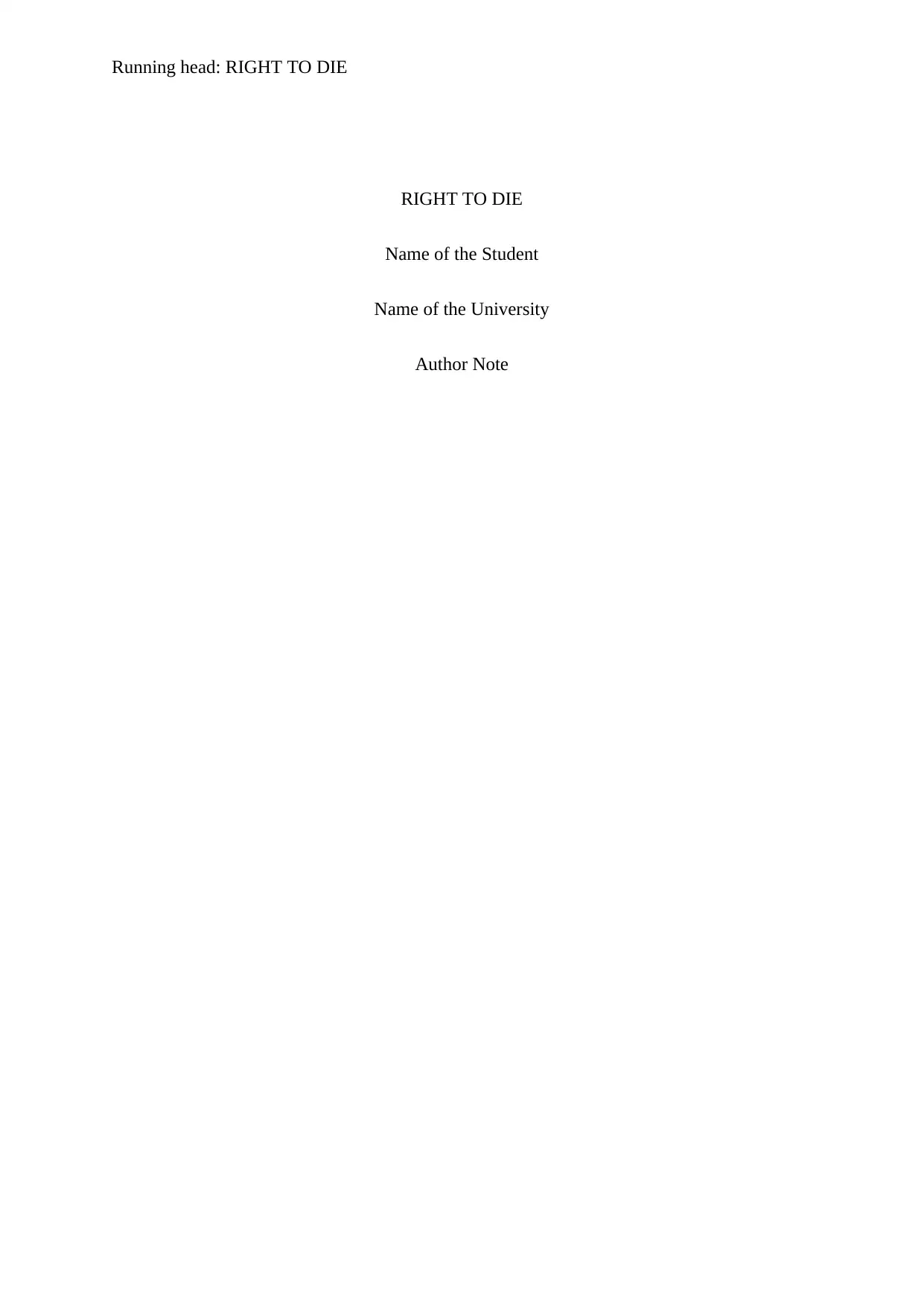
Running head: RIGHT TO DIE
RIGHT TO DIE
Name of the Student
Name of the University
Author Note
RIGHT TO DIE
Name of the Student
Name of the University
Author Note
Paraphrase This Document
Need a fresh take? Get an instant paraphrase of this document with our AI Paraphraser
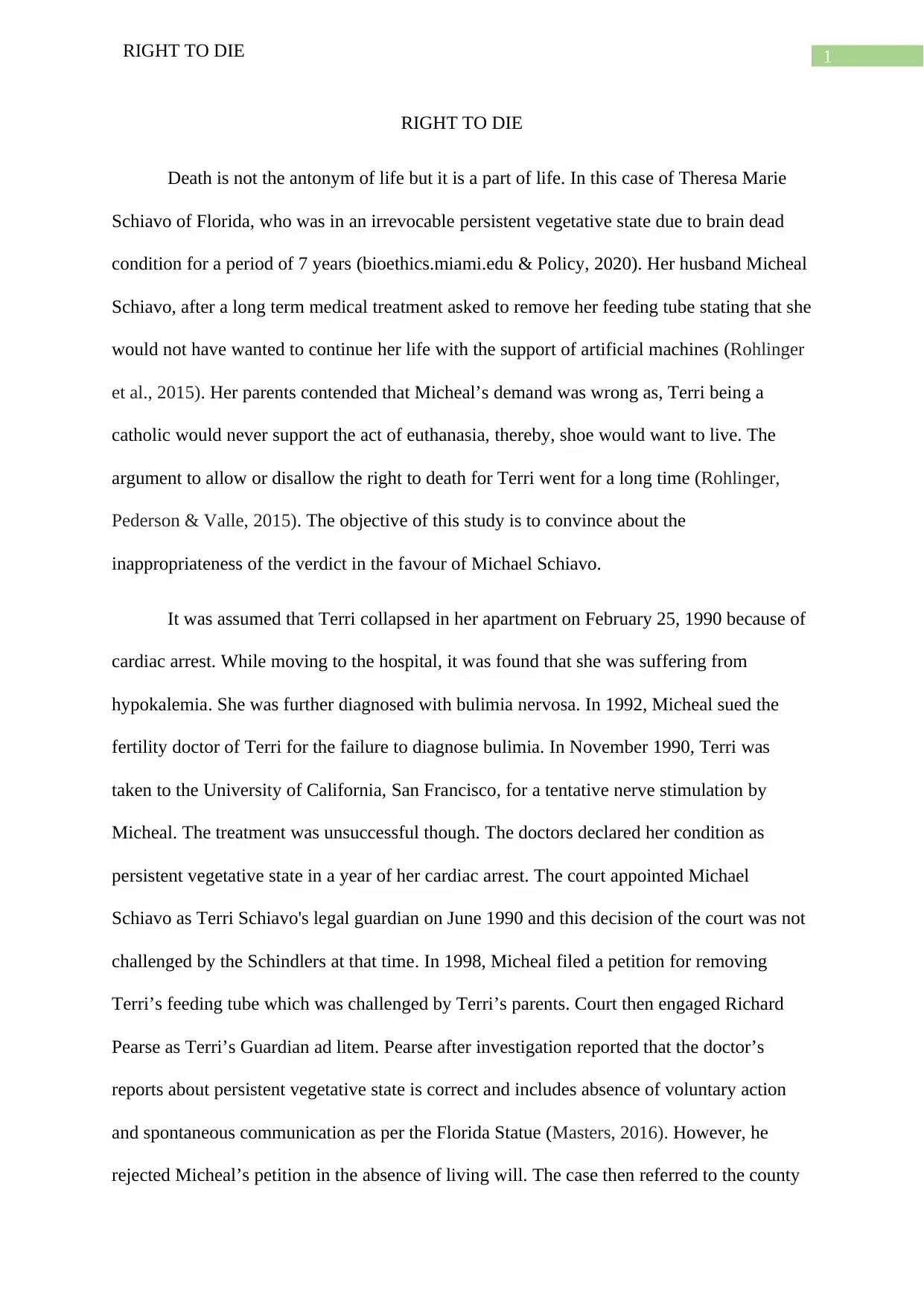
1RIGHT TO DIE
RIGHT TO DIE
Death is not the antonym of life but it is a part of life. In this case of Theresa Marie
Schiavo of Florida, who was in an irrevocable persistent vegetative state due to brain dead
condition for a period of 7 years (bioethics.miami.edu & Policy, 2020). Her husband Micheal
Schiavo, after a long term medical treatment asked to remove her feeding tube stating that she
would not have wanted to continue her life with the support of artificial machines (Rohlinger
et al., 2015). Her parents contended that Micheal’s demand was wrong as, Terri being a
catholic would never support the act of euthanasia, thereby, shoe would want to live. The
argument to allow or disallow the right to death for Terri went for a long time (Rohlinger,
Pederson & Valle, 2015). The objective of this study is to convince about the
inappropriateness of the verdict in the favour of Michael Schiavo.
It was assumed that Terri collapsed in her apartment on February 25, 1990 because of
cardiac arrest. While moving to the hospital, it was found that she was suffering from
hypokalemia. She was further diagnosed with bulimia nervosa. In 1992, Micheal sued the
fertility doctor of Terri for the failure to diagnose bulimia. In November 1990, Terri was
taken to the University of California, San Francisco, for a tentative nerve stimulation by
Micheal. The treatment was unsuccessful though. The doctors declared her condition as
persistent vegetative state in a year of her cardiac arrest. The court appointed Michael
Schiavo as Terri Schiavo's legal guardian on June 1990 and this decision of the court was not
challenged by the Schindlers at that time. In 1998, Micheal filed a petition for removing
Terri’s feeding tube which was challenged by Terri’s parents. Court then engaged Richard
Pearse as Terri’s Guardian ad litem. Pearse after investigation reported that the doctor’s
reports about persistent vegetative state is correct and includes absence of voluntary action
and spontaneous communication as per the Florida Statue (Masters, 2016). However, he
rejected Micheal’s petition in the absence of living will. The case then referred to the county
RIGHT TO DIE
Death is not the antonym of life but it is a part of life. In this case of Theresa Marie
Schiavo of Florida, who was in an irrevocable persistent vegetative state due to brain dead
condition for a period of 7 years (bioethics.miami.edu & Policy, 2020). Her husband Micheal
Schiavo, after a long term medical treatment asked to remove her feeding tube stating that she
would not have wanted to continue her life with the support of artificial machines (Rohlinger
et al., 2015). Her parents contended that Micheal’s demand was wrong as, Terri being a
catholic would never support the act of euthanasia, thereby, shoe would want to live. The
argument to allow or disallow the right to death for Terri went for a long time (Rohlinger,
Pederson & Valle, 2015). The objective of this study is to convince about the
inappropriateness of the verdict in the favour of Michael Schiavo.
It was assumed that Terri collapsed in her apartment on February 25, 1990 because of
cardiac arrest. While moving to the hospital, it was found that she was suffering from
hypokalemia. She was further diagnosed with bulimia nervosa. In 1992, Micheal sued the
fertility doctor of Terri for the failure to diagnose bulimia. In November 1990, Terri was
taken to the University of California, San Francisco, for a tentative nerve stimulation by
Micheal. The treatment was unsuccessful though. The doctors declared her condition as
persistent vegetative state in a year of her cardiac arrest. The court appointed Michael
Schiavo as Terri Schiavo's legal guardian on June 1990 and this decision of the court was not
challenged by the Schindlers at that time. In 1998, Micheal filed a petition for removing
Terri’s feeding tube which was challenged by Terri’s parents. Court then engaged Richard
Pearse as Terri’s Guardian ad litem. Pearse after investigation reported that the doctor’s
reports about persistent vegetative state is correct and includes absence of voluntary action
and spontaneous communication as per the Florida Statue (Masters, 2016). However, he
rejected Micheal’s petition in the absence of living will. The case then referred to the county
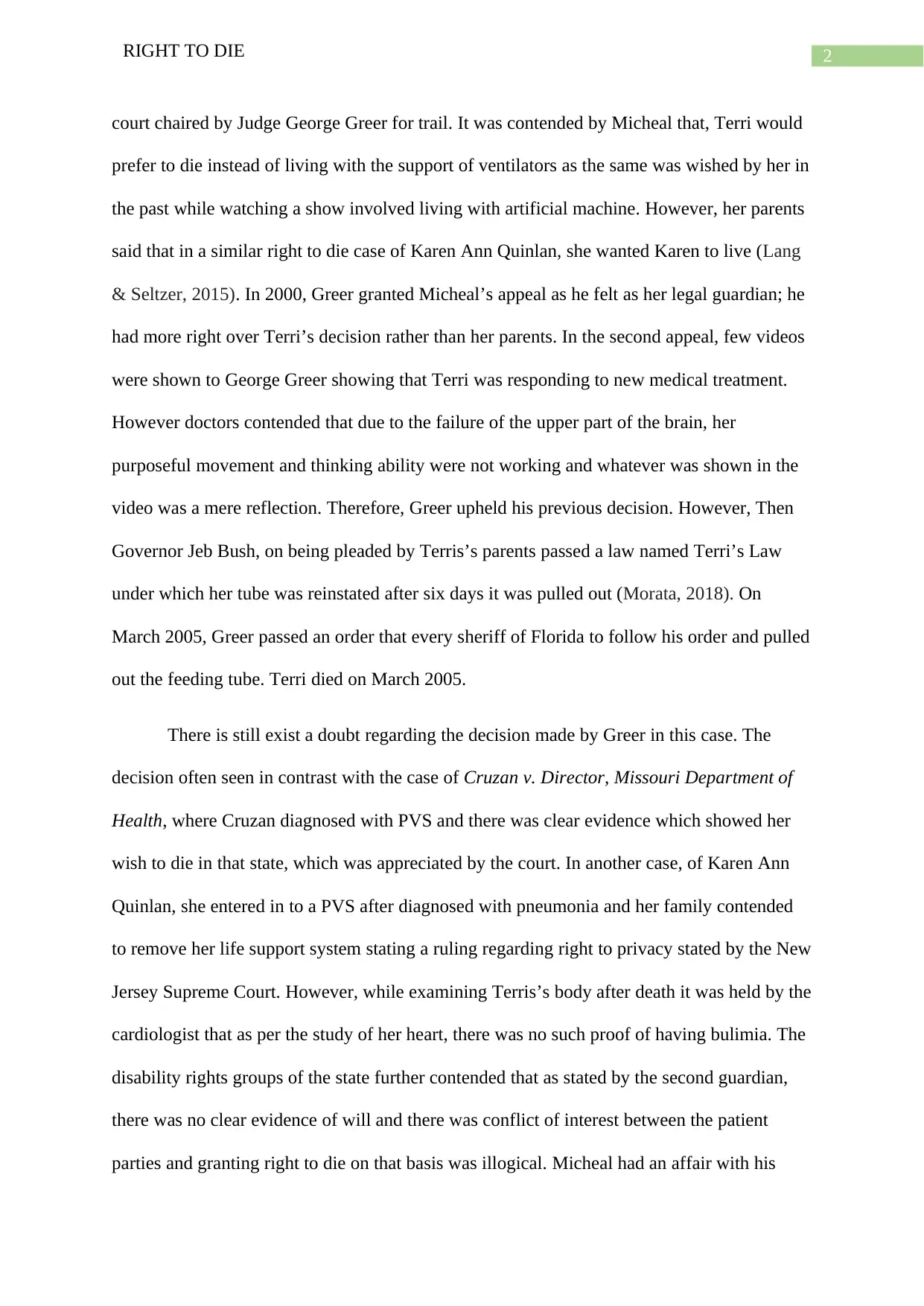
2RIGHT TO DIE
court chaired by Judge George Greer for trail. It was contended by Micheal that, Terri would
prefer to die instead of living with the support of ventilators as the same was wished by her in
the past while watching a show involved living with artificial machine. However, her parents
said that in a similar right to die case of Karen Ann Quinlan, she wanted Karen to live (Lang
& Seltzer, 2015). In 2000, Greer granted Micheal’s appeal as he felt as her legal guardian; he
had more right over Terri’s decision rather than her parents. In the second appeal, few videos
were shown to George Greer showing that Terri was responding to new medical treatment.
However doctors contended that due to the failure of the upper part of the brain, her
purposeful movement and thinking ability were not working and whatever was shown in the
video was a mere reflection. Therefore, Greer upheld his previous decision. However, Then
Governor Jeb Bush, on being pleaded by Terris’s parents passed a law named Terri’s Law
under which her tube was reinstated after six days it was pulled out (Morata, 2018). On
March 2005, Greer passed an order that every sheriff of Florida to follow his order and pulled
out the feeding tube. Terri died on March 2005.
There is still exist a doubt regarding the decision made by Greer in this case. The
decision often seen in contrast with the case of Cruzan v. Director, Missouri Department of
Health, where Cruzan diagnosed with PVS and there was clear evidence which showed her
wish to die in that state, which was appreciated by the court. In another case, of Karen Ann
Quinlan, she entered in to a PVS after diagnosed with pneumonia and her family contended
to remove her life support system stating a ruling regarding right to privacy stated by the New
Jersey Supreme Court. However, while examining Terris’s body after death it was held by the
cardiologist that as per the study of her heart, there was no such proof of having bulimia. The
disability rights groups of the state further contended that as stated by the second guardian,
there was no clear evidence of will and there was conflict of interest between the patient
parties and granting right to die on that basis was illogical. Micheal had an affair with his
court chaired by Judge George Greer for trail. It was contended by Micheal that, Terri would
prefer to die instead of living with the support of ventilators as the same was wished by her in
the past while watching a show involved living with artificial machine. However, her parents
said that in a similar right to die case of Karen Ann Quinlan, she wanted Karen to live (Lang
& Seltzer, 2015). In 2000, Greer granted Micheal’s appeal as he felt as her legal guardian; he
had more right over Terri’s decision rather than her parents. In the second appeal, few videos
were shown to George Greer showing that Terri was responding to new medical treatment.
However doctors contended that due to the failure of the upper part of the brain, her
purposeful movement and thinking ability were not working and whatever was shown in the
video was a mere reflection. Therefore, Greer upheld his previous decision. However, Then
Governor Jeb Bush, on being pleaded by Terris’s parents passed a law named Terri’s Law
under which her tube was reinstated after six days it was pulled out (Morata, 2018). On
March 2005, Greer passed an order that every sheriff of Florida to follow his order and pulled
out the feeding tube. Terri died on March 2005.
There is still exist a doubt regarding the decision made by Greer in this case. The
decision often seen in contrast with the case of Cruzan v. Director, Missouri Department of
Health, where Cruzan diagnosed with PVS and there was clear evidence which showed her
wish to die in that state, which was appreciated by the court. In another case, of Karen Ann
Quinlan, she entered in to a PVS after diagnosed with pneumonia and her family contended
to remove her life support system stating a ruling regarding right to privacy stated by the New
Jersey Supreme Court. However, while examining Terris’s body after death it was held by the
cardiologist that as per the study of her heart, there was no such proof of having bulimia. The
disability rights groups of the state further contended that as stated by the second guardian,
there was no clear evidence of will and there was conflict of interest between the patient
parties and granting right to die on that basis was illogical. Micheal had an affair with his
⊘ This is a preview!⊘
Do you want full access?
Subscribe today to unlock all pages.

Trusted by 1+ million students worldwide
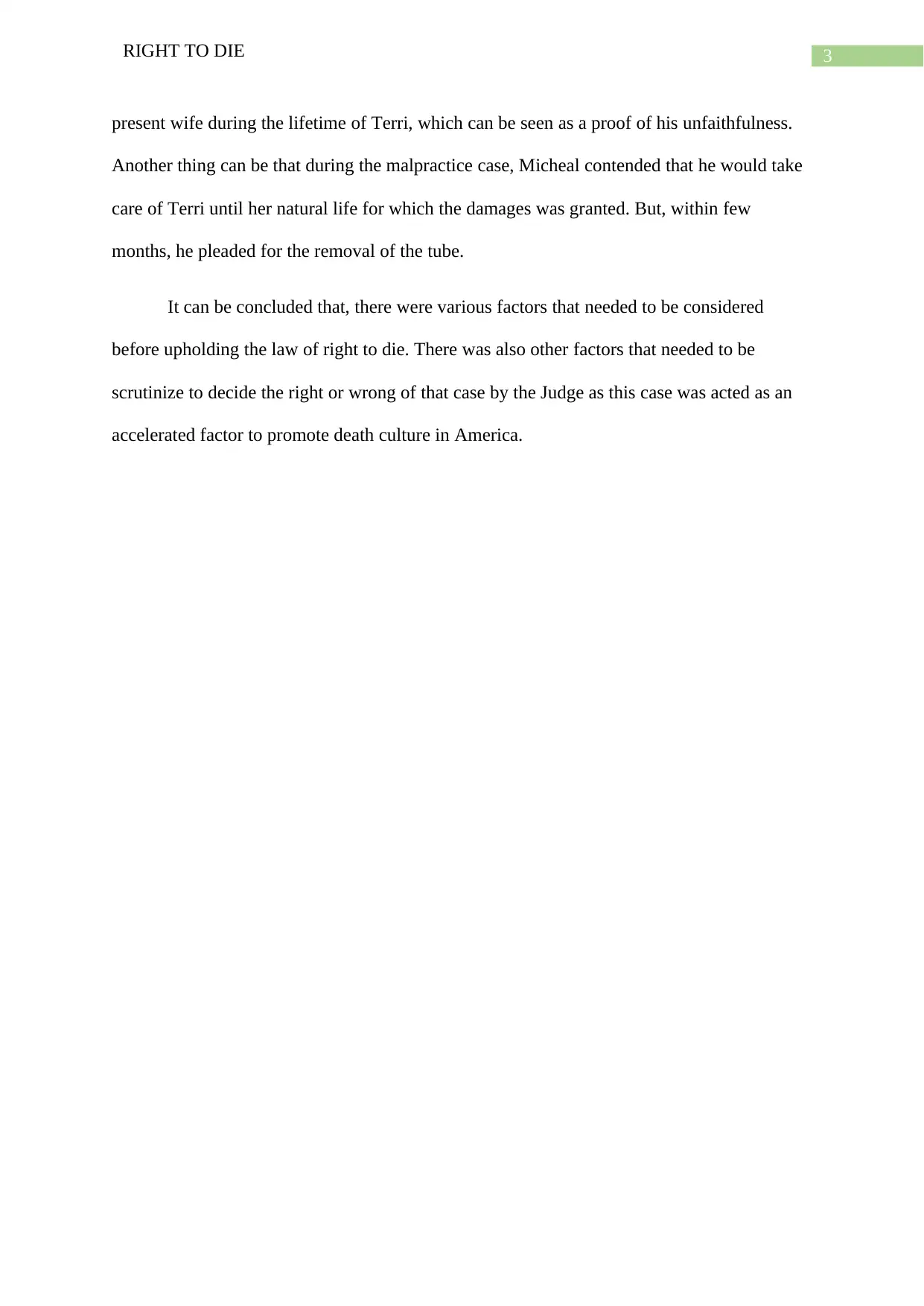
3RIGHT TO DIE
present wife during the lifetime of Terri, which can be seen as a proof of his unfaithfulness.
Another thing can be that during the malpractice case, Micheal contended that he would take
care of Terri until her natural life for which the damages was granted. But, within few
months, he pleaded for the removal of the tube.
It can be concluded that, there were various factors that needed to be considered
before upholding the law of right to die. There was also other factors that needed to be
scrutinize to decide the right or wrong of that case by the Judge as this case was acted as an
accelerated factor to promote death culture in America.
present wife during the lifetime of Terri, which can be seen as a proof of his unfaithfulness.
Another thing can be that during the malpractice case, Micheal contended that he would take
care of Terri until her natural life for which the damages was granted. But, within few
months, he pleaded for the removal of the tube.
It can be concluded that, there were various factors that needed to be considered
before upholding the law of right to die. There was also other factors that needed to be
scrutinize to decide the right or wrong of that case by the Judge as this case was acted as an
accelerated factor to promote death culture in America.
Paraphrase This Document
Need a fresh take? Get an instant paraphrase of this document with our AI Paraphraser
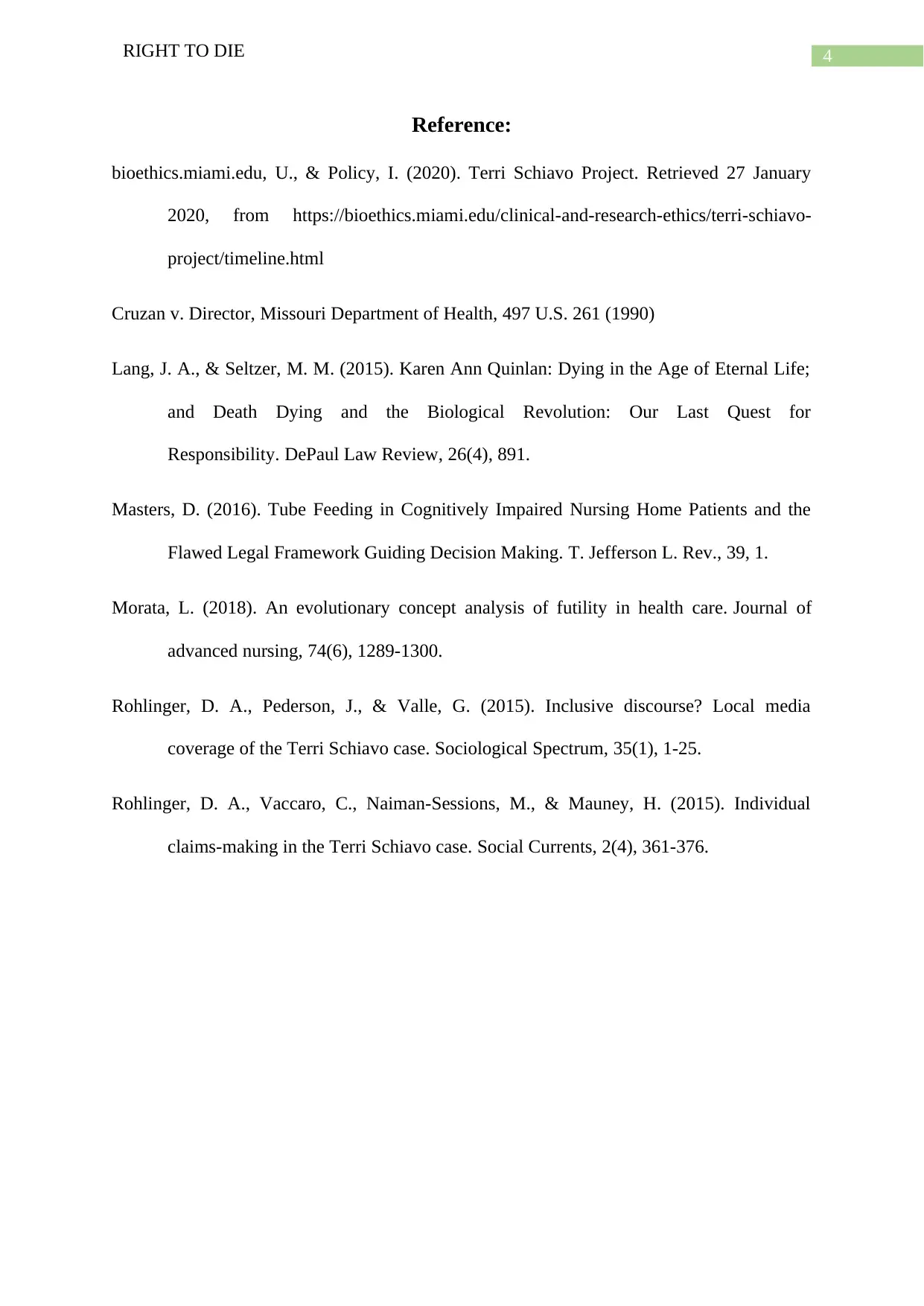
4RIGHT TO DIE
Reference:
bioethics.miami.edu, U., & Policy, I. (2020). Terri Schiavo Project. Retrieved 27 January
2020, from https://bioethics.miami.edu/clinical-and-research-ethics/terri-schiavo-
project/timeline.html
Cruzan v. Director, Missouri Department of Health, 497 U.S. 261 (1990)
Lang, J. A., & Seltzer, M. M. (2015). Karen Ann Quinlan: Dying in the Age of Eternal Life;
and Death Dying and the Biological Revolution: Our Last Quest for
Responsibility. DePaul Law Review, 26(4), 891.
Masters, D. (2016). Tube Feeding in Cognitively Impaired Nursing Home Patients and the
Flawed Legal Framework Guiding Decision Making. T. Jefferson L. Rev., 39, 1.
Morata, L. (2018). An evolutionary concept analysis of futility in health care. Journal of
advanced nursing, 74(6), 1289-1300.
Rohlinger, D. A., Pederson, J., & Valle, G. (2015). Inclusive discourse? Local media
coverage of the Terri Schiavo case. Sociological Spectrum, 35(1), 1-25.
Rohlinger, D. A., Vaccaro, C., Naiman-Sessions, M., & Mauney, H. (2015). Individual
claims-making in the Terri Schiavo case. Social Currents, 2(4), 361-376.
Reference:
bioethics.miami.edu, U., & Policy, I. (2020). Terri Schiavo Project. Retrieved 27 January
2020, from https://bioethics.miami.edu/clinical-and-research-ethics/terri-schiavo-
project/timeline.html
Cruzan v. Director, Missouri Department of Health, 497 U.S. 261 (1990)
Lang, J. A., & Seltzer, M. M. (2015). Karen Ann Quinlan: Dying in the Age of Eternal Life;
and Death Dying and the Biological Revolution: Our Last Quest for
Responsibility. DePaul Law Review, 26(4), 891.
Masters, D. (2016). Tube Feeding in Cognitively Impaired Nursing Home Patients and the
Flawed Legal Framework Guiding Decision Making. T. Jefferson L. Rev., 39, 1.
Morata, L. (2018). An evolutionary concept analysis of futility in health care. Journal of
advanced nursing, 74(6), 1289-1300.
Rohlinger, D. A., Pederson, J., & Valle, G. (2015). Inclusive discourse? Local media
coverage of the Terri Schiavo case. Sociological Spectrum, 35(1), 1-25.
Rohlinger, D. A., Vaccaro, C., Naiman-Sessions, M., & Mauney, H. (2015). Individual
claims-making in the Terri Schiavo case. Social Currents, 2(4), 361-376.
1 out of 5
Related Documents
Your All-in-One AI-Powered Toolkit for Academic Success.
+13062052269
info@desklib.com
Available 24*7 on WhatsApp / Email
![[object Object]](/_next/static/media/star-bottom.7253800d.svg)
Unlock your academic potential
Copyright © 2020–2025 A2Z Services. All Rights Reserved. Developed and managed by ZUCOL.



